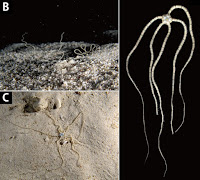 |
| Ophiopsila xmasilluminans Okanishi, Oba & Fujita, 2019 |
Abstract
Three species of ophiuroids are reported from a shallow water submarine cave on Christmas Island in northwestern Australia, including a new bioluminescent species, Ophiopsila xmasilluminans, which is described herein on the basis of 15 specimens. This new species occurs on sandy bottoms in the cave with disc buried and arms extended above the substratum. This species possesses a disc entirely covered by thick skin with small and delicate embedded scales and granules; 3 oral papillae, basically flat, fan-shaped but sometimes innermost or middle papilla spiniform; diamond shaped oral shield with rounded edges, as long as wide; long and flat arm spine; inner tentacle scale narrow, flat and long, arms approximately 18 times the disc diameter. We describe bioluminescence and burying behaviour, which suggest adaptation to submarine cave environments. Also reported herein is a rarely encountered species, Ophiomora elegans, based on a single specimen. Ophiomora elegans was previously known only from southern Mozambique, the east coast of Africa and the Ryukyu Islands. We also include a new record of Ophioconis claviculata, which was previously known only from the Ryukyu Islands.
Key words: brittle star, endemism, new species, submarine cave, bioluminescence, Christmas Island
Ophiopsila xmasilluminans new species
Diagnosis. Disc surface entirely covered by thick skin with embedded small and delicate scales and granules; 3 oral papillae, basically as scales, but sometimes spiniform for one on innermost or middle position; diamond-shaped oral shield with rounded edges, as long as wide; long and flat arm spines, 6 in maximum number; inner tentacle scale narrow, flat and long; arms approximately 18 times longer than disc diameter.
Etymology. The specific name is an adjective in apposition formed as a compound of the island name “xmas” and the Latin participle, illuminans, meaning “lighting”, referring to its sampling locality name (Christmas Island) and luminescence.
Common Japanese name. Dohkutsu-hikari-kumohitode.
Distribution. Known only from the type locality, a submarine cave called as “Thunderdome Cave”, northern coast of Christmas Island, northwestern Australia, approximately 10 m depth (type locality, Fig. 1). Tan et al (2014) noted that Ophiopsila pantherina [= this new species] was also found at “Thundercliff Cave”, which is located near Thunderdome Cave. However, specimens of this species were only collected from Thunderdome Cave by the last author (Yoshihisa Fujita).
Habitat. All type specimens of Ophiopsila xmasilluminans new species were collected in sandy bottoms in the submarine cave, with buried disc and arms extended into the water (Fig. 2B).
Masanori Okanishi, Yuichi Oba and Yoshihisa Fujita. 2019. Brittle Stars from A Submarine Cave of Christmas Island, northwestern Australia, with Description of A New Bioluminescent Species Ophiopsila xmasilluminans (Echinodermata: Ophiuroidea) and Notes on Its Behaviour. RAFFLES BULLETIN OF ZOOLOGY. 67: 421–439. DOI 10.26107/RBZ-2019-0034
南の島のクリスマスイルミネーション?クリスマス島(豪)の海底洞窟から新種の光るクモヒトデを発見! (大場裕一教授ら) 中部大学の研究活動 中部大学 www3.chubu.ac.jp/research/news/25228/






